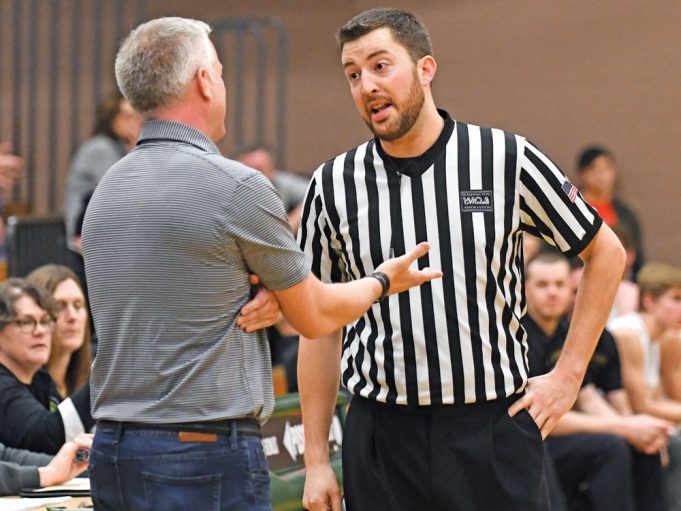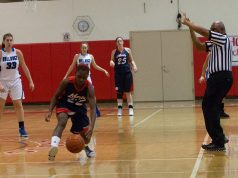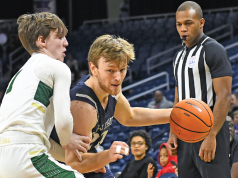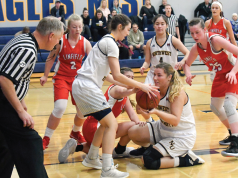The NBA continues to have a real problem with “flopping.” League officials recently levied some fines and penalties for “faking being fouled,” and the rampant problem subsided somewhat, but hasn’t gone away completely.
Will high school basketball ever make this issue a point of emphasis? Will the NFHS, or local association trainers going it alone, ever prompt their basketball officials to get serious about curbing the practice with the tools available? Is this an issue in your area? Are you willing to “pull the trigger” and use the tools available to you in the rules, but lacking a rational explanation for those who would criticize you as an over-officious official? Does it matter?
Players sometimes put a lot of effort into “faking being fouled.” Have you ever had a player “flop” with all the acting abilities of a Broadway superstar? No illegal contact has taken place, yet a dramatic fall to the floor is theatrically executed. Defensive player sets up for a charge but, when the dribbler pulls up for a jumper instead, or redirects to the right or left and avoids all contact altogether, he or she falls backward, acting as if smashed into by a freight train when the player really wasn’t. Perhaps slight contact does occur on a play, but the player reacts as if hit in the chest by a cannon, begging for an illegitimate call.
Faking a foul can merit a technical foul
NFHS rule 10-4-6f clearly states that “faking being fouled” merits the issuance of a player technical foul. But is that the first choice in the official’s repertoire? Maybe not.
This begs the question, under what circumstances and when should you for sure call a player technical for “faking being fouled”? Are there any other tactics to employ short of ruling a player T? When might you have no choice?
Often players intending to illegitimately hit the deck do so, but take themselves out of the play for ensuing rebounding action or for participation in a transition the other way. In that case, those players have really penalized themselves through the resulting inability to benefit their team on the following play. That is a situation where you may want to warn the player about the attempt to “fool the referee” to get a call in a deceiving fashion. That often solves the problem. Furthermore, the coach will probably also yell at the player to play better defense, which curbs a future similar incident of “faking being fouled.”
A less-preferred method, at least by approved mechanics, is to give that “I saw you were trying to fool me … I’m not giving you that … get up and play the game” signal. That’s not an approved signal, and neither is it much of an effective tool. The player you’re signaling to probably isn’t looking at you at that time anyway, so all you’re doing is justifying your no-call. We don’t do that with superfluous, unapproved signals. We should let our no-call speak for itself and not adopt unapproved signals to “cover ourselves.”
Other times, you may have warned players to “knock it off” but they don’t get the message and do it again. Any warning followed by non-compliance renders your generous warning ineffective. Fail to follow up with what you’re getting at in this situation and you broadcast the message to that player and everyone else that you don’t really mean it when you issue a warning.
If a member of your crew has cautioned a team on one end, be sure to be consistent and do the same if it occurs at the other end. You don’t want to hand out a “T” immediately on the other end after merely cautioning on the first occurrence by the other team.
What if you’ve cautioned both teams and yet a “faking being fouled” incident occurs in spite of that? Issue the 10-4-6f player technical. The player didn’t heed the caution and that’s the only way your preliminary, tactful, preventive message will have any teeth.
There might be a real issue of player safety
Yet again, there might be a real issue of safety involved that means you’d serve the game best by calling a “T” the first time the “faking being fouled” happens. That’s when the player, though not fouled, or merely contacted to an insignificant extent, takes a dive and poses a danger to other players in the immediate area of the ensuing action. For example, a player lobbies for a charge right in the middle of the lane, and after he or she goes down, other players trip all over the player in the rebounding action that follows the shot.
That’s a safety issue. The player’s actions posed a real threat to the welfare of the other players, even some of his or her own teammates. Then the issuance of a player technical wouldn’t be out of place. You have an expressed responsibility to protect all players from unnecessary risk of injury. Whack him or her. It probably won’t happen again the rest of the game.
Another situation might happen on a three-point attempt. It is very common for the defender to box out the shooter after the shot has been released. Sometimes the box out is really displacement, and the shooter hits the floor either before or after returning to the floor. When that happens, displacement must be called.
But what if the shooter strategizes “faking being fouled”? No unreasonable illegal contact has occurred, but, begging for a foul, the player jumps backward, hits the floor and complains (along with his or her coach) over the feigned contact. Decision time on your part. Effectively, the player has taken him or herself out of the ensuing play. Is that penalty enough? Quite possibly. If it happens over and over again, that’s against the spirit of the rules of the game. That’s deception. Especially if the coach has been made aware of a previous warning given, the player technical you feel is merited will not receive much protest.
There are times when “faking being fouled” can and can’t be ignored. And when it can’t, the rules give you a tool to use. Rule 10-4-6f. It’s there for a reason. Use it when necessary. And you’ll find the judicious issuance of this player technical will curb what’s just gotta be curbed.
What's Your Call? Leave a Comment:
Note: This article is archival in nature. Rules, interpretations, mechanics, philosophies and other information may or may not be correct for the current year.
This article is the copyright of ©Referee Enterprises, Inc., and may not be republished in whole or in part online, in print or in any capacity without expressed written permission from Referee. The article is made available for educational use by individuals.


















